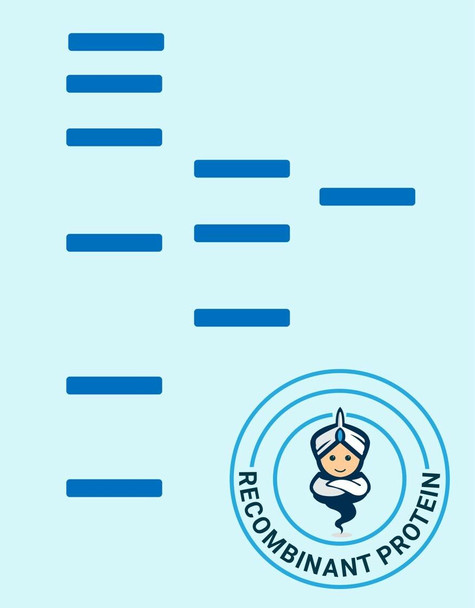Description
| Product Name: | Mouse F3 Recombinant Protein |
| Product Code: | RPPB5885 |
| Size: | 10µg |
| Species: | Mouse |
| Target: | F3 |
| Synonyms: | Tissue factor, TF, Coagulation factor III, CD142. |
| Source: | Sf9 Insect cells |
| Physical Appearance: | Sterile Filtered colorless solution. |
| Formulation: | F3 protein solution (0.5mg/ml) contains Phosphate Buffered Saline (pH 7.4) and 10% glycerol. |
| Stability: | Store at 4°C if entire vial will be used within 2-4 weeks. Store, frozen at -20°C for longer periods of time.�For long term storage it is recommended to add a carrier protein (0.1% HSA or BSA).�Avoid multiple freeze-thaw cycles. |
| Purity: | Greaterthan 95.0% as determined by SDS-PAGE. |
| Amino Acid Sequence: | ADPAGIPEKA FNLTWISTDF KTILEWQPKP TNYTYTVQIS DRSRNWKNKC FSTTDTECDL TDEIVKDVTW AYEAKVLSVP RRNSVHGDGD QLVIHGEEPP FTNAPKFLPY RDTNLGQPVI QQFEQDGRKL NVVVKDSLTL VRKNGTFLTL RQVFGKDLGY IITYRKGSST GKKTNITNTN EFSIDVEEGV SYCFFVQAMI FSRKTNQNSP GSSTVCTEQW KSFLGEHHHH HH |
Tissue factor is well-known as the main cellular initiator of blood coagulation. The Tissue factor gene encodes coagulation factor III which is a cell surface glycoprotein that enables cells to initiate the blood coagulation cascades, and functions as the high-affinity receptor for the coagulation factor VII. Following vessel injury, the Tissue Factor and Factor VIIa complex activates the coagulation protease cascade, which leads to fibrin deposition and activation of platelets. The ensuing complex presents a catalytic event, which is responsible for initiation of the coagulation protease cascades by specific limited proteolysis. Therefore, Tissue factor has a role in normal hemostasis by initiating the cell-surface assembly and propagation of the coagulation protease cascade. Tissue Factor can also be stimulated by the inflammatory mediators interleukin 1 and TNF, as well as by endotoxin, to appear on monocytes and vascular endothelial cells as a component of cellular immune response.Tissue factor is the only one in the coagulation pathway for which a congenital deficiency has not been described. Certain levels of Tissue Factor are essential for the maintained viability and growth of endothelium and Tissue Factor-expressing tumor cells. Additionally, abnormal Tissue Factor expression inside the vasculature initiates life threatening thrombosis in various diseases, for example sepsis, atherosclerosis, and cancer. Alternative spliced Tissue Factor expression advances tumor growth, and is linked to increased tumor cell proliferation and angiogenesis in pancreatic cancer.
F3 produced in Sf9 Baculovirus cells is a single,glycosylated polypeptide chain containing 232 amino acids (29-251 a.a.) andhaving a molecular mass of 26.4kDa (Migrates at 28-40kDa on SDS-PAGE underreducing conditions).F3 is expressed with a 6 amino acid His tag at C-Terminusand purified by proprietary chromatographic techniques.
| UniProt Protein Function: | F3: Initiates blood coagulation by forming a complex with circulating factor VII or VIIa. The [TF:VIIa] complex activates factors IX or X by specific limited protolysis. TF plays a role in normal hemostasis by initiating the cell-surface assembly and propagation of the coagulation protease cascade. Interacts with HSPE; the interaction, inhibited by heparin, promotes the generation of activated factor X and activates coagulation in the presence of activated factor VII. TF expression is highly dependent upon cell type. TF can also be induced by the inflammatory mediators interleukin 1 and TNF-alpha, as well as by endotoxin, to appear on monocytes and vascular endothelial cells as a component of cellular immune response. Lung, placenta and pancreas. Belongs to the tissue factor family. 2 isoforms of the human protein are produced by alternative splicing. |
| UniProt Protein Details: | Protein type:Cell surface; Membrane protein, integral Cellular Component: cell surface; cytoplasm; extracellular matrix; extracellular space; integral to membrane; membrane; plasma membrane Molecular Function:hematopoietin/interferon-class (D200-domain) cytokine receptor activity; phospholipid binding; protease binding Biological Process: activation of plasma proteins during acute inflammatory response; blood coagulation; caspase activation; cytokine and chemokine mediated signaling pathway; hemostasis; positive regulation of angiogenesis; positive regulation of endothelial cell proliferation; positive regulation of protein kinase B signaling cascade; positive regulation of smooth muscle cell migration |
| NCBI Summary: | This gene encodes a membrane-bound glycoprotein that forms the primary physiological initiator of the blood coagulation process following vascular damage. The encoded protein binds to coagulation factor VIIa and the ensuing complex catalyzes the proteolytic activation of coagulation factors IX and X. Mice lacking encoded protein die in utero resulting from massive hemorrhaging in both extraembryonic and embryonic vessels. A severe deficiency of the encoded protein in mice results in impaired uterine homeostasis, shorter life spans due to spontaneous fatal hemorrhages and cardiac fibrosis. [provided by RefSeq, Aug 2015] |
| UniProt Code: | P20352 |
| NCBI GenInfo Identifier: | 135667 |
| NCBI Gene ID: | 14066 |
| NCBI Accession: | P20352.2 |
| UniProt Related Accession: | P20352 |
| Molecular Weight: | 32,935 Da |
| NCBI Full Name: | Tissue factor |
| NCBI Synonym Full Names: | coagulation factor III |
| NCBI Official Symbol: | F3�� |
| NCBI Official Synonym Symbols: | TF; Cf3; Cf-3; CD142; AA409063�� |
| NCBI Protein Information: | tissue factor |
| UniProt Protein Name: | Tissue factor |
| UniProt Synonym Protein Names: | Coagulation factor III; CD_antigen: CD142 |
| Protein Family: | Tissue factor |
| UniProt Gene Name: | F3�� |
| UniProt Entry Name: | TF_MOUSE |






